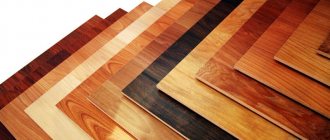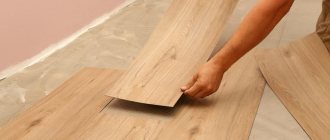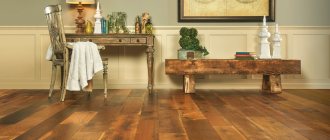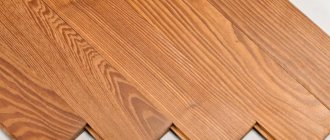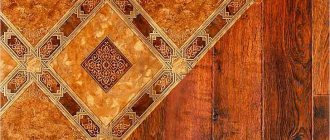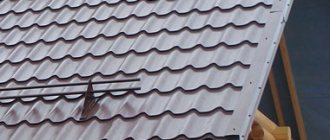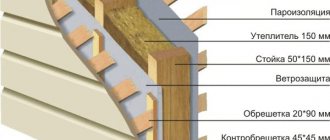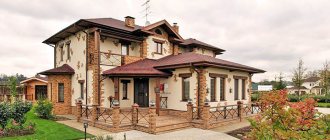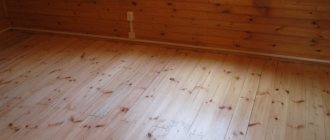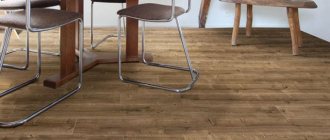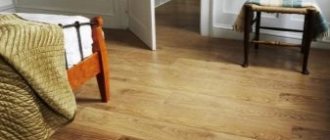It is not easy to clearly choose which is better between laminate and parquet boards. Their numerous pros and cons confuse many buyers. But if, when purchasing a floor finish, environmental safety and naturalness are of paramount importance, then they usually take planks made of solid wood. And if you need a cheap and practical material, then the choice is often made in favor of a laminated coating based on MDF. However, not all so simple. Before you go to the store, you should carefully study both options from all sides.
What is the difference between plank and laminate
Externally, the finishing coatings under consideration are similar. They are also installed using a similar technology, using tongue-and-groove locks at the end.
However, the top layer of laminate is made from acrylic and melamine resins. And the parquet board on top is made of hardwood, which is varnished. Moreover, both options are a factory product completely ready for installation on the floor. There is no need to process or varnish them afterwards.
Design features of laminate and parquet boards
Another important difference between parquet boards and laminate is the middle load-bearing layer. In the first case, it is made from solid wood blocks, and in the second from MDF. If we compare finishes in terms of strength, durability and wear resistance, then a high-quality laminated coating of class “33” or “34” from factory-made parquet in the form of multilayer dies will win by a serious margin.
Repair
Individual fragments of the laminate can only be replaced if it was laid in a floating manner by interlocking the planks. If glue was used during installation, replacing the damaged laminate strip will be very problematic.
However, even if you manage to find the same type of laminate that was installed, the new plank may stand out from the rest due to fading and wear of the latter. Laminate cannot be sanded or laminated.
Parquet boards are easier to repair (although you need to understand that this is an expensive undertaking). If the damage is extensive, you can sand the parquet completely and then varnish or oil it. If the damage is localized, individual boards can be replaced. Hand-scrapping technology can be applied to parquet, creating a very beautiful floor with an aging effect.
Old parquet can be sanded and re-varnished or oiled
Advantages and disadvantages of laminate
Among the advantages of laminate are:
- good resistance to moisture;
- environmental Safety;
- high resistance to abrasion and scratches;
- increased strength against pushing through furniture;
- simplicity and ease of care;
- UV resistance;
- variety of designs and colors.
Like parquet boards, high-quality laminated coating does not emit harmful substances. And if it has a top layer made using antistatic technology, then dust will not stick to it. This is the best solution for children's and living rooms.
Advantages of laminate
The main disadvantage of laminate is its artificiality. When entering a room with it, you can immediately see that under your feet there is a covering made of non-natural material. And, despite all the protection from melamine and acrylic, if water gets to the MDF, the laminated lamella will inevitably swell and become unusable.
Tips for choosing
Let's start with basic tips for choosing quality parquet:
- Familiarize yourself with the parquet manufacturing companies, as well as the packaging in which the material is located. It should be made of cardboard and have no holes.
- If you have a device for measuring humidity, do not be lazy to use it. Humidity should not be more than ten percent.
- Cracks, scratches and damage are unacceptable.
What to consider when choosing a laminate:
- The most important thing is to familiarize yourself with the coating class. The first digit of the class indicates the type of premises: 2 – residential, 3 – public. The second number is the degree of frequency of walking on the surface.
- The thicker the laminate, the higher its sound insulation and strength.
- The permissible concentration of formaldehyde in the composition is designated as F1.
Sliding wardrobe in a long corridor.
See how to properly glue vinyl wallpaper here.
Room for a man design photo: https://trendsdesign.ru/home/bedroom/dizajn-zhilya-molodogo-muzhchiny.html
Pros and cons of parquet boards
Factory parquet boards have the following advantages:
- naturalness and naturalness of the material;
- aesthetic appearance;
- antistatic varnish coating;
- increased sound insulation;
- easy installation without the need for sanding and varnishing.
Compared to laminated flooring, parquet is more demanding on the microclimate in the room. High humidity and constant temperature changes are contraindicated for it. Also, parquet varnish is less durable and wear-resistant than a melamine protective layer. In rooms with high traffic, it is best to install laminate slats.
Advantages of parquet boards
Which is less afraid of water?
It is not obvious, but parquet boards are less afraid of water than laminate flooring. Wood has a memory effect - parquet swells from water, but after drying it restores its original shape. Having chosen a quality manufacturer, the only thing that may remind you of a flood is the darkened edges of the planks, and if you choose an oil-based coating, a washed away protective layer.
With laminate, everything is worse - HDF swells from water and does not recover after drying. After slight flooding, the edges of the laminate bend and wear out quickly. Good manufacturers make HDF boards that are denser and contain water-repellent particles, which is good at resisting water absorption, but in any case, laminate is very afraid of water.
Comparison of parameters
To choose between parquet boards and laminate, you need to weigh all their advantages and disadvantages. In some cases, it is recommended to lay parquet on the floor, while in others, on the contrary, its laminated counterpart is recommended. There is no universal solution for all situations.
Ability to withstand loads
Due to the use of durable MDF in the manufacture of the load-bearing layer, the laminate is able to withstand greater loads from above than a board. In most cases, the first option will last much longer than the second - 20–25 years versus 10–15.
The top layer of the parquet type in question is made of high-strength wood. However, underneath there are cheaper and less durable pine bars. At the same time, even solid oak can be pressed through by point pressure between the wood fibers. As a result, the parquet board is inferior in strength to all laminated lamellas of class “33” and higher.
Laminate classes
Temperature and moisture resistance
In terms of resistance to temperature changes and moisture, laminate is also in first place. Melamine and acrylic protect MDF from water more reliably than solid wood varnish. For rooms with high humidity and heated floors, a laminated finish would be the best choice.
Durability
If you need a coating with the longest possible service life, then when choosing a laminate or parquet board, you should give preference to the first. Slats made from solid MDF are more durable than panels made from blocks of wood.
Plus, the outer layer on them is more wear-resistant and less susceptible to scratches. However, if necessary, parquet can be restored by removing the varnish and sanding the wood again. And in case of damage, its counterpart will have to be completely changed in the entire room.
Unlike laminate, parquet boards can be restored
Soundproofing
In terms of noise and echoing, parquet boards perform slightly better than laminate flooring. Due to its internal porosity, multilayer wood dampens sounds well. Moreover, both coatings are noisy materials. If the sound insulation factor is very important, then it is recommended to choose linoleum or carpet for the floor.
To improve the sound insulation of a children's room, decorate it with parquet boards
Appearance
From an aesthetic point of view, natural wood of noble species is in a obviously more advantageous position. But laminated coatings are distinguished by a variety of patterns, which come not only with wood texture, but also with stone, metal, multi-color patterns, etc.
It all depends on the preferences of the owner of the house. Some people don’t like the standard sizes of plastic windows; they want to enlarge the window opening or, on the contrary, narrow it slightly.
What is the difference between parquet board and laminate
Difficulty of installation
In terms of installation technology, the finishes in question have virtually no differences. In both cases, the standard step-by-step instructions for laying laminate flooring with your own hands will do the job.
To lay both coverings, you will need to level the base, lay out a polyethylene foam backing (if glue is not used) and assemble the floor covering together from individual elements. These individual strips are connected using end locks.
Laying laminate and parquet boards does not require special skills
Price
Parquet boards will cost more than laminate. In the first case, the cost of a square floor starts from 1000 rubles/m2, and in the second from 200–300 rubles/m2. However, the price of a high-quality laminated coating with a high wear resistance class is at least 800–900 rubles/m2. With relatively the same quality, the difference will not be very large.
What's more beautiful?
Parquet has an ideal appearance, each board is unique, you can feel any knot on the surface, a parquet board is no less beautiful up close than from afar. The chamfer of the parquet board is natural and continues the texture of the wood. Decorative treatments, such as deep brushing and scarring, look great because oils and even varnishes spread well, accurately repeating the relief. In addition to shiny models, there are a huge number of matte and ultra-matte models that do not have parasitic shine.
Laminate: Printed images on any laminate have insufficient detail (resolution), so when viewed from a distance of less than 1 meter, the laminate looks artificial. A more important problem is that the image does not have full coverage of natural shades; the limited spectrum of color gives off an imitation of wood, when the eye clings to the unnatural gradient of halftones. Decorative film is produced in sheets - usually about 2 m², and the laminate has a repeatability of the strips, which is noticeable to the naked eye. It is difficult to make the chamfer of a laminate natural; the edges are almost always painted with one even color due to technical limitations, which, of course, does not look natural. Alternatively, there are models with a U-shaped bevel, which shows the grain of the wood, but this bevel is not found in wood floors, so the solution is a compromise. The laminate is covered with two films that are not very elastic, so there are visual problems with simulating brushing, scarring, cross cuts and other popular wood treatments. An imitation can be done, but it will not be as subtle and deep. Another problem with films is that the laminate shines, like under glass. There are very expensive options that achieve a matte surface, but this is an exception to the general rule.
Where and what is better to lay
If a heated floor is installed in the room, then it is better to immediately make the choice of “get parquet or laminate” in favor of the second one. The board may only be placed on top of a water heater with a maximum heating temperature of no higher than 25–26 0C. Plus, the coating should be heated evenly over the entire area of the room. And we must remember that wood is a poor conductor of heat. The parquet floor will take a very long time to warm up.
Aesthetic parquet is ideal for offices, as well as living rooms, libraries and halls in private homes. It is best to install laminate flooring in bedrooms, hallways and children's rooms. And for bathrooms, kitchens and balconies, its moisture-resistant version is more suitable. There is no need to use parquet boards in cold rooms or with high humidity.
Parquet board in the interior
Comparison table of characteristics
Summarize:
| Parquet board | Laminate |
|
|
Myths about parquet and laminate
Both coatings under consideration appeared on the Russian market not so long ago. There are quite a lot of fables and myths around them. And the two main questions that buyers constantly have are the environmental friendliness and maintainability of these floor finishes.
Laminates are an artificial material. However, if it is not a cheap fake, then it does not emit formaldehyde or anything else and is completely safe. It is impossible to call it natural and natural, like wood. But it is also impossible to focus on the artificiality or harm to human health of the laminated coating.
In terms of maintainability, parquet is much better than its competitor. However, to make such repairs, you must have special skills in working with wood.
And with laminate the situation is also not so clear. You won't be able to laminate a worn-out area of flooring yourself. But if one lamella was left in reserve, then it is quite possible to put it instead of any worn one. The shade of such a replacement will be slightly different, especially if the finish has been in the room under the sun for many months. But repairs are possible, the main thing is not to use glue during installation initially.
When choosing between parquet boards and laminate, consider many factors
You can choose parquet or laminate based on appearance
Of course, natural wood is beautiful. The typesetting patterns on the floors in museums invariably evoke admiration, although in homes the traditional “Christmas tree” looks simpler. To slightly diversify the color, you can choose a varnish with an unusual shade. However, a tree will always remain a tree. Even if it’s spectacular and of a rare variety.
The type of lamellas is distinguished by a huge variety of not only colors, but also textures. Modern laminated surfaces successfully imitate wood and stone. With the help of special paints and chamfers, they completely replicate the look of any material. Only a professional will notice the difference between an expensive laminate and parquet.
To understand what a chamfer is, just compare any parquet and laminated surface. The parquet floors have visible joints. The play of light and shadow makes the flooring voluminous. High-quality lamellas fit together so well that the joints are invisible, the surface looks monolithic; to see the boundaries, you need to look closely. The chamfers on the lamellas are made to make the flooring more natural and similar to a parquet floor.
Conclusion
Before choosing laminate or parquet boards for your home, you should think carefully. Reviews for both finishes are very mixed. Parquet is beautiful and luxurious, but laminated flooring outperforms it in terms of wear resistance and durability. Plus, these options are not suitable for every room. For bathrooms, washrooms and kitchens, you should choose something more moisture-resistant.
See also the video, which is better: parquet board or laminate:
Read about our other materials:
Do-it-yourself siding on a house
How to properly install plumbing in a country house?
Understanding the materials
What is the difference between laminate and parquet boards, what are the advantages and disadvantages of each multilayer coating and what to choose? To answer all these questions, you should first understand what parquet and laminate flooring are.
What is a parquet board?
Surely, when you heard the phrase “parquet board”, you imagined stacked piece parquet - small boards laid in a herringbone pattern. However, the difference between these floor coverings is colossal:
- natural parquet flooring (parquet) is a solid sawn block made of valuable wood;
- parquet board is a layer cake, which contains not only high-quality wood species, but also fiberboard, as well as a varnish protective layer.
The difference from expensive parquet is also in size: a parquet board has a maximum length and width of 20*250 cm (instead of 9*50 cm). The thickness of the board is 14 mm (instead of 18-22). And the last difference is the locking connection. In fact, parquet boards are more like laminate - they are multi-layered and easy to install.
The appearance, service life and other characteristics of the board depend on the composition. In the classic version, it consists of three components: the bottom layer of coniferous wood ensures durability, the middle layer is laid perpendicularly and serves as a connector (made from solid pine or birch), the top protective layer is responsible for wear resistance (oak, teak, wenge, ash, beech) .
To create a slab of increased durability, the cross bars are replaced with a more stable modern material - HDF. It promotes sound insulation and better tolerates humid environments and temperature changes.
The final factory coating gives an advantage over parquet planks: unlike its natural counterpart, the parquet board is coated with varnish, oil, impregnation or other protective compound at the factory. This stage ensures resistance to abrasion, mechanical stress, moisture, ease of use and cleaning.
What is laminate?
Laminated coating is also multilayer, but it is based not on wood veneer, but on fiberboard/chipboard boards. Standard lamella layers:
- Lower. The task is to protect against water and impart rigidity. The backing is made of melamine.
- Basic. The task is the connecting link. Made from fiberboard or particleboard.
- Decorative. The task is to imitate wood, stone or any other texture, pattern, color. Consists of printed paper.
- Upper layer. The task is protection from humidity, mechanical damage, and burnout. Achieved using acrylic or melamine resin.
The quality of each layer and its exact composition influence the grade of the resulting laminated coating. After a series of tests for strength, sound insulation, water resistance and abrasion, the laminate is classified as household (starts with the number 2) or commercial (with the number 3). The second one is certainly of higher quality, but the price of such flooring is higher.
Parquet – what do you need to remember when choosing cladding?
In recent years, owners often choose parquet or laminate for floor finishing: the popularity of these materials is explained by their attractive visual characteristics and excellent performance. However, both types of coating have not only positive qualities, but also disadvantages, which should not be forgotten if you want to decorate the surfaces in your home as efficiently as possible.
First, we will look at the features of parquet flooring. Parquet boards are made from several layers of natural wood, which are securely fastened to each other with glue. A special pattern is applied to the top layer of each board, matching the structure of natural wood, which ensures the attractiveness of the cladding.
The bottom layer of the board is 1–2 mm thick and is made of spruce or pine plywood. The second layer is assembled from narrow lamellas of the same types of wood, which are glued perpendicular to the bottom layer, which provides the parquet with better wear resistance. The third, top layer of the board reaches a thickness of 3–4 mm and is usually made of valuable wood species (oak, ash, beech and others). This layer is treated on top with special protective compounds that increase the durability and aesthetic characteristics of the board.
The positive qualities of parquet boards usually include:
- Naturalness. The material is made entirely from layers of natural wood, which are joined together with non-toxic, human-safe glue.
- Easy to install. Laying parquet can be done with your own hands, without the involvement of professional installers.
- Attractiveness. Parquet is beautiful in itself, and by using various installation methods you can use it to create unique and aesthetic design compositions in the room.
- Ease of use. Almost any dirt can be easily removed with a damp cloth without the use of chemicals.
- Long service life. With proper care, parquet can last for several decades.
An important advantage of parquet boards is that if the coating loses its original gloss over time, it can be easily restored by sanding. But parquet also has disadvantages. The main ones are the low resistance of the cladding to moisture, fading under the influence of sunlight, and the tendency to become saturated with odors. In addition, parquet boards are quite easily damaged due to mechanical stress, although the resulting defects can be eliminated by sanding.
The principle of laminate construction
The very name of this type of coating comes from the structural features. The term translates as “multilayer coating”. It is the structure that provides the features of this type of coating, which include both pros and cons.
The main difference between laminate and parquet boards is its design. The stabilizing layer of the laminate is chipboard (fibreboard). It is responsible for the fireproof properties of the laminate. Under the chipboard there is a layer of plastic or paper impregnated with resinous substances, which guarantees the material protection from moisture. Treating all edges with a wax-containing impregnation also protects the boards from moisture.
The top layer is decorative, made of paper. It is he who is responsible for the attractiveness of the coating. It can be very different - wood, with a tile pattern, stone, with any fashionable texture.
A high-quality print allows you to accurately convey the texture, which makes the coating very similar to natural. The top layer is coated with melamine resin, which gives it strength, reliably retains color and protects it from external influences. It does not fade, does not lose brightness, does not scratch, does not get wet.
